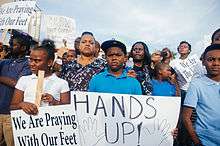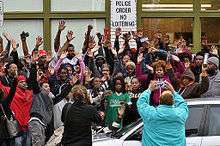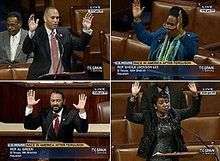Hands up, don't shoot


"Hands up, don't shoot", or simply "hands up", is a slogan and gesture that originated after the August 9, 2014 shooting of Michael Brown. The slogan was adopted at protests against police violence. While several witnesses claimed Brown's hands were in the air when he was shot, a United States Department of Justice investigation found that physical and forensic evidence contradicted this claim.
Origin
On Saturday, August 9, 2014, Michael Brown and Dorian Johnson were walking together in Ferguson, Missouri. They were stopped by Officer Darren Wilson. After becoming fearful for his safety, Officer Wilson shot and killed Michael Brown.[1]
One recurring feature in Dorian Johnson's eyewitness account of the incident is that Michael Brown put his hands in the air during the encounter with Officer Wilson. A typical recollection by Dorian Johnson was phrased as "[Michael Brown] turned around, and he put his hands in the air, and he started to get down."[2] Three days after the killing of Michael Brown, Johnson told MSNBC that Brown said, "I don’t have a gun, stop shooting!"[3]
In addition to Johnson, several witnesses to the shooting of Michael Brown described him as having his hands up during the encounter. However, no one else recalled Brown asking Wilson not to shoot his firearm.[4][5]
Impromptu protests erupted immediately after the shooting. Tension between the community and the police escalated quickly.[6] Shortly after the shooting, Brown's stepfather held a placard that read "Ferguson police just executed my unarmed son!!!" By 8:30 that same evening, demonstrators were chanting "We are Michael Brown!". They also marched to the headquarters of the Ferguson Police Department, where they chanted "No justice! No peace!" Residents also held their hands in the air and said to police officers "Don't shoot me!"[7] The St. Louis Post-Dispatch photographed protesters with their hands in the air shouting "Don't shoot us!" at the police.[8]
The community reaction to Michael Brown's death continued through Sunday, August 10 with a variety of actions, including more protests and a vigil, as well as looting.[9] On Monday, August 11, as the FBI promised to investigate the shooting, and the NAACP organized a meeting in the community, the hands up gesture was still being employed by protesters who believed they were emulating the final posture of Michael Brown.[10] After the looting on Sunday, police officers were equipped with rubber bullets and tear gas on Monday night. During a standoff with police, several men approached officers with their hands raised saying, "Don't shoot me."[11]
The hands up pose had been widely adopted by protesters throughout the weekend. The gesture was often paired with the phrase "Don't shoot me" or "Don't shoot us". During the demonstrations on Monday, the media first documented the posture and the phrase being combined into the slogan "Hands Up, Don't Shoot".[10]
Usage
By Tuesday, August 13, "Hands Up, Don't Shoot" had become a defining slogan of the protests in Ferguson.[12] The hands up gesture used widely by black males when dealing with Ferguson police was transformed into a weapon of protest. Al Sharpton encouraged demonstrators to use the gesture by saying, "If you're angry, throw your arms up. If you want justice, throw your arms up. Because that's the sign Michael was using. He had a surrender sign. That's the sign you have to deal with. Use the sign he last showed. We want answers why that last sign was not respected."[13]
The hybrid slogan "Hands Up, Don't Shoot" quickly spread beyond the Ferguson protests. It was often said in solidarity with the protesters in Ferguson.[14][15][16][17]
Black Lives Matter
Though the Black Lives Matter activist movement began in response to the death of Trayvon Martin two years earlier, it staged its first in-person national protest in the form of a "Black Lives Matter Freedom Ride" to Ferguson, Missouri three weeks after the shooting of Michael Brown. One of the rallying cries at those protests was "Hands Up, Don't Shoot".[18] This became a common chant at Black Lives Matter protests, along with the dying words of Eric Garner ("I can't breathe"),[19] and "No justice, no peace".[20]
Members of the St. Louis Rams football team
On November 30, 2014, several players on the St. Louis Rams (Tavon Austin, Stedman Bailey, Kenny Britt, Jared Cook and Chris Givens)[21] entered the field during a National Football League (NFL) game making the gesture.
The St. Louis Police Officers Association said the act was "way out-of-bounds" and the organization "is profoundly disappointed with the members of the St. Louis Rams football team who chose to ignore the mountains of evidence released from the St. Louis County Grand Jury this week and engage in a display that police officers around the nation found tasteless, offensive, and inflammatory".[22][23]
Rams Coach Jeff Fisher and a team spokesman said that they were unaware of the players' plans before the game and the players "were exercising their right to free speech".[24] Against the St. Louis Police Officers Association's request, the NFL did not punish the players, because the gesture was political and unlike other major professional sports leagues NFL does not punish players for political gestures.[21] The NFL's vice president of communications said, "We respect and understand the concerns of all individuals who have expressed views on this tragic situation."[21]
Jared Cook, one of the Rams players, received threats after making the gesture.[25]
Capitol Hill
On December 1, 2014, several lawmakers in the United States House of Representatives made the gesture to protest the shooting and police brutality. Rep. Hakeem Jeffries (D-New York) said on the floor:
Hands up, don't shoot. It's a rallying cry of people all across America who are fed up with police violence. In community, after community, after community, fed up with police violence in Ferguson, in Brooklyn, in Cleveland, in Oakland, in cities and counties and rural communities all across America.[26]
Other members of the Congressional Black Caucus joining Jeffries were Reps. Yvette Clarke (D-New York), Al Green (D-Texas) and Sheila Jackson Lee (D-Texas), who praised the football players who made the gesture the night before.[26]
On December 11, more than 150 black congressional staffers staged a walkout and silent protest in a display of unity with demonstrations against the Eric Garner and Brown grand jury decisions. Senate Chaplain Dr. Barry Black led the crowd in prayer. They were gathered there, Black said, to be a "voice for the voiceless". After prayer, the crowd of staff and lawmakers posed while making the gesture.[27][28]
CNN Newsroom
On December 13, after a story about the ongoing protest, three members of the CNN Newsroom panel held up their hands while a fourth held up a sheet of paper reading "I can't breathe", a reference to the death of Eric Garner. "Our hearts are with [the protesters]" was stated, but "hands up, don't shoot" was not said during the broadcast. The gesture attracted criticism because it appeared on a non-opinion-based program.[29]
In Music
During Pharrell Williams' performance of the song "Happy" at the 57th Annual Grammy Awards, the singer and backup performers made the hands up gesture.[30]
Hong Kong
From September to December 2014, protesters in Hong Kong rallied against the Chinese government's reversal of its promise to grant them full democratic rights. During what became known as the Umbrella Revolution, protesters reacted to the heavy-handed tactics of the police by invoking the "Hands Up, Don't Shoot" chant.[31]
Criticism
In response to the homicide of Michael Brown, the Criminal Section of the Department of Justice Civil Rights Division, the United States Attorney’s Office for the Eastern District of Missouri, and the Federal Bureau of Investigation opened an investigation into whether or not Officer Wilson violated federal laws.
On March 4, 2015, the Department of Justice released their report of the investigation. This report found that physical and forensic evidence contradicted witnesses who claimed that Brown had his hands up when Wilson shot him. It also stated that witnesses whose testimony aligned with the physical and forensic evidence never "perceived Brown to be attempting to surrender at any point when Wilson fired upon him." The report concluded there was no justification for a federal prosecution of Officer Wilson.[32][33]
In the wake of the report, many pundits began to refer to the "Hands up, Don't Shoot" slogan as "a lie" or "based on a lie".[34][35][36] The Washington Post's Fact Checker feature gave "Hands Up, Don't Shoot" four Pinocchios.[37]
Despite this criticism, the slogan has an enduring symbolic meaning for activists. As one protester remarked, "Even if you don't find that it's true, it's a valid rallying cry... it's just a metaphor."[38][39][40] Speaking to the Daily Mail, Elizabeth Brondolo, a psychology professor at St. John's University in New York, said "The truth always really matters, but it's important to recognize that past experience to stereotypes also influences the perception of hands being raised."[41]
See also
- Black Lives Matter
- Hands Up United
- List of gestures
- List of killings by law enforcement officers in the United States, August 2014
External links
- Dorian Johnson recalling the shooting (CBC News)
- Department of Justice Report (pdf)
- Video of demonstrators chanting "Hands Up, Don't Shoot" on Monday, August 11, 2014. (Twitter)
References
- ↑ Bosman, Julie, Campbell Robertson, Erik Eckholm, and Ricard A. Oppel Jr., "Amid Conflicting Accounts, Trusting Darren Wilson", New York Times. November 25, 2014. Accessed: August 5, 2016.
- ↑ "Michael Brown shooting: Police delay public ID of officer who shot teen". CBC News. August 12, 2014. Retrieved August 1, 2016.
- ↑ Lee, Trymaine. "Eyewitness to Michael Brown shooting recounts his friend’s death", MSNBC. August 12, 2014. Accessed: August 1, 2016.
- ↑ Grinberg. Emanuella. "Why 'hands up, don't shoot' resonates regardless of evidence", CNN. January 11, 2015. Accessed: August 2, 2016.
- ↑ Eyewitness: Michael Brown had his hands in the air, 2014-08-14, retrieved 2015-04-29
- ↑ Follman, Mark. "Michael Brown's Mom Laid Flowers Where He Was Shot—and Police Crushed Them". Mother Jones. Retrieved September 19, 2014.
- ↑ Thorsen, Lea. "FERGUSON DAY ONE WRAPUP: Officer kills Ferguson teen", St. Louis Post Dispatch. August 10, 2014. Accessed: August 1, 20216.
- ↑ "Editorial: Michael Brown and disparity of due process", St. Louis Post-Dispatch. August 11, 2014. Accessed: August 1, 2016.
- ↑ Giegerich, Steve. "FERGUSON DAY TWO WRAPUP: Day of protests, night of frenzy", St. Louis Post-Dispatch. August 11, 2014. Accessed: August 10, 2016.
- 1 2 "FERGUSON DAY THREE WRAPUP: Calls for Justice", St. Louis Post-Dispatch. August 12, 2014. Accessed: August 30, 2016.
- ↑ Bosman, Julie; Goode, Erica. "F.B.I. Steps In Amid Unrest After Police Kill Missouri Youth", The New York Times. August 12, 2014. Accessed: September 1, 2016.
- ↑ Williams, Lauren. "Hands up, don't shoot: The images that define Ferguson's protests", Vox. August 13, 2014. Accessed: August 9, 2016.
- ↑ Pearce, Matt. "Protesters use hands-up gesture defiantly after Michael Brown shooting", The Los Angeles Times, August 12, 2014. Accessed: August 10, 2016.
- ↑ Alund, Natalie Neysa. "Oakland: Residents rally against police shootings, support Ferguson protesters", Oakland Tribune. August 14, 2014.
- ↑ Jones, Erica. "Howard University Students Show Solidarity for Slain Mo. Teen", NBC Washington. August 14, 2014. Accessed: September 1, 2016.
- ↑ Associated Press. "VIDEO: Redskins show ‘hands up’ solidarity with Ferguson protesters". August 19, 2014. Accessed: August 15, 2016.
- ↑ Walters, Joanna. "Thousands march in New York over Garner and Brown police deaths", The Guardian. August 23, 2014. Accessed: September 2, 2016.
- ↑ Ruffin, Herbert. "Black Lives Matter: The Growth of a New Social Justice Movement". blackpast.org. Retrieved November 10, 2015.
- ↑ Phillip, Abby (December 11, 2014). "Protesting racial injustice while white". The Washington Post. ISSN 0190-8286. Retrieved November 18, 2015.
- ↑ Ford, Glen (November 10, 2015). "Tamir Rice and the Meaning of "No Justice – No Peace"". Black Agenda Report. Retrieved November 18, 2015.
- 1 2 3 Woody, Christopher; Geary, Molly (December 1, 2014). "NFL Won't Discipline Rams Players for 'Hands Up, Don't Shoot' Gesture". Time. Retrieved December 2, 2014.
- ↑ Alter, Charlotte (December 1, 2014). "St. Louis Cops Condemn Rams' 'Hands Up, Don't Shoot' Gesture". Time. Retrieved December 2, 2014.
- ↑ Bump, Philip (December 1, 2014). "Rep. Hakeem Jeffries (D-N.Y.) brings 'Hands up, don't shoot' to House floor". The Washington Post. Retrieved December 2, 2014.
- ↑ "No fines for Rams players' salute". ESPN. Retrieved December 4, 2014.
- ↑ "Rams player says he received threats after 'Hands up, don't shoot' protest". CNN. Retrieved December 4, 2014.
- 1 2 McCalmont, Lucy (December 2, 2014). "Lawmakers make 'hands up' gesture on House floor". Politico. Retrieved December 2, 2014.
- ↑ "Black Congressional Staffers Stage Powerful 'Hands Up, Don't Shoot' Protest". New York. Retrieved December 12, 2014.
- ↑ "Capitol Hill's Black Staffers Walk Out to Say 'Hands Up, Don't Shoot!'". The Daily Beast. Retrieved December 12, 2014.
- ↑ Connor, Jackson. "CNN Hosts Under Fire For Putting 'Hands Up' On Air, Critics Claim Bias". The Huffington Post. Retrieved December 17, 2014.
- ↑ Opam, Kwame (2015-02-09). "Pharrell's Grammy performance was a hopeful yet muddled statement about race in America". The Verge. Retrieved 2016-05-26.
- ↑ Fisher, Max (September 28, 2014). "Hong Kong's protesters are using the same "hands up, don't shoot" gesture used in Ferguson". Vox. Retrieved July 28, 2016.
- ↑ Diamond, Jeremy (March 5, 2015). "What the Department of Justice Ferguson report says about 'Hands up, don't shoot'". CNN.
- ↑ Department of Justice Report Regarding the Criminal Investigation into the Shooting Death of Michael Brown by Ferguson, Missouri Police Officer Darren Wilson (PDF), March 4, 2015
- ↑ Capehart, Jonathan. "‘Hands up, don’t shoot’ was built on a lie", The Washington Post. March 16, 2015. Accessed: September 2, 2016
- ↑ Megan, Kelly (July 26, 2016). "The Kelly File". The Kelly File. Fox News.
Let me just clarify the matter of Michael Brown, because there's a lot of confusion about this. He was -- his case helped lead to the birth of Black Lives Matter and the "hands up, don't shoot" mantra, which turned out to be a lie, according to the [Department of Justice].
- ↑ Jeanine, Pirro (July 29, 2016). "The O'Reilly Factor". The O'Reilly Factor. Fox News.
[Black Lives Matter] was based on a lie: Hands up, don't shoot.
- ↑ Michelle Ye Hee Lee (19 March 2015). "'Hands up, don't shoot' did not happen in Ferguson". Washington Post.
- ↑ "For some, location of Brown's hands irrelevant". Fox News. Associated Press. Retrieved December 4, 2014.
- ↑ "'Hands Up, Don't Shoot' Is Bigger than Ferguson and Bigger than the Rams". VICE Sports. Retrieved December 4, 2014.
- ↑ "Beyond 'Hands Up, Don't Shoot': what if there's no indictment in Ferguson?". The Guardian. Retrieved December 4, 2014.
- ↑ Evans, Sophie Jane (November 29, 2014). "Did Michael Brown ever really say, 'Hands up, don't shoot'? Ferguson protesters' rallying cry may be based on a lie". Daily Mail. Retrieved December 17, 2014.
